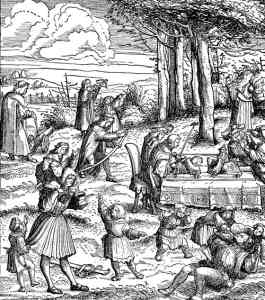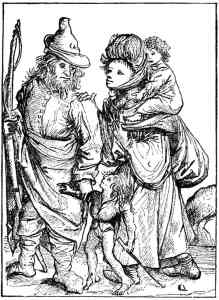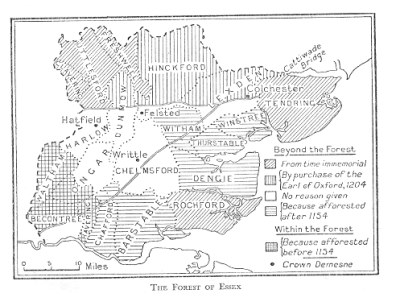Life in the Elizabethan Era

HOMES
By this era most people had
houses although there was a vast difference between rich and poor
accommodation.
The most common house was a
wooden frame with weatherboard
Rooms in each house were used
for living and sleeping with separate buildings for animals.
Houses of rich people were
usually built with stone or bricks.
Seating for people consisted
of benches or stools.
Chairs and upholstery was the
province of the wealthy
Tables were usually of trestle
style with lengths of wooden planking on a frame.
Beds were often low wooden
frames containing a mattress stuffed with straw, feathers or
whatever soft material was available. The bed was covered by a
blanket to keep the occupant warm.
Wealthier residents would have
a higher bed with a better mattress and linen sheets and feather
stuffed pillows.
Some beds had canopies to
increase warmth and decrease light
Internal lighting was achieved
by candles
Many windows had glass fitted
although curtains did not come into use until later eras
CHILD LIFE EXPECTANCY
The average adult life
expectancy was much lower than nowadays.
Large families were the norm
as it was accepted that many children would die when young.
Many children became Orphans
whilst still young and were cared for by relatives or sometimes
scavenged a living.
There were some charities to
help the poor which relied on local bequests.
A local example is Ayletts
Charity covering Tillingham and area.
FOOD and DRINK
Food was confined to that
available in seasons with the exception of items that were pickled
or salted.
Meat was normally roasted over
an open fire or stewed in a pot over a wood fire.
Access to eels, fish,
shellfish and rabbits provided poor people with access to some meat.
Porridge/ Gruel was another
part of staple diet.
Dairy products were made on
most farms and so were purchased locally.
Access to milk/ butter etc was
an important part of family life to farm workers.
Beer was the main beverage
drunk by all of the family as tea and coffee did not become
available to normal people until the late 1700's
Wealthier residents would have
large kitchens and produce varied dishes although they were still
restricted to food in season.
Food was eaten with a knife or
with fingers

CHEESE
The marshlands of Eastern
Essex are the only areas in Essex recorded as producing cheese from
sheep.
Although Essex Cheese was held
in high renown the remainder of the cheese makers in the county made
their cheese from cows milk
Sheep are the main livestock
in the area Cheese and butter were made from Ewes milk in large huts
known as wicks.
To this day many farms in the
old marshland have the appendix wick in their name i.e. Middlewick,
providing clues to their past.
Ewes cheese became popular as
a winter food as the cheese was more moist than cows cheese and
lasted longer through the winter.
The process of making cheese
started with putting the milk into a wooden pail, then warming the
milk and adding rennet to make the milk curdle.
After a while hard sediment
would form on the bottom of the pail with a clear liquid on top.
The liquid was poured away and
the sediment placed in a cloth bag which was put into a press where
it was left for a few days to allow the cheese to solidify.
In cold times of the year the
area of the press was often kept warm to help the cheese ripen.
Most sheep farmers would make
their own cheese to farm a staple part of the farmers diet and to
sell in the local markets.
FOREST
In medieval time Essex was
largely forested in an area called the Kings Forest of Essex. There
were large areas of heath land with bracken and heather as well as
forest. Hunting was the perogative of the monarch which made taking
deer an offence punished by death or disfigurement .This must have
been a great temptation for the poor and hungry residents.
The forest was useful for
providing firewood and for grazing for pigs and cattle.
Nowadays this is difficult to
believe given the few trees in our area. The ancient bounds of the
forest surveyed in 1291 included the entire Dengie Hundred including
St Peters Chapel and Creeksea.
Even in later years the new
parish church as St Lawrence was called St Lawrence Newland as it
was new land cut from the forest.
The earth in this area was so
fertile that over the years more and more forest was cut back for
agriculture shrinking the forest into the existing Epping Forest.

SPORT
During Elizabethan times sport
was discouraged with archery being the only exception.
Every father had to give his
sons and servants who were aged from 7 to 16 with a longbow and two
arrows and every man aged 17 to 60 had to own a longbow and 4
arrows.
Each parish had to provide
archery butts every Sunday to allow parishioners to practice their
skills.
Failure to comply with this
obligation in 1591 led to the residents of Purleigh being fined 12d
each having not practiced for 10 months.
The main sport in the many
alehouses was a game that we know as shove ha-penny which was played
with groats (the small currency of the time).
Although the game was unlawful
in many parts of the country it was still commonly played as the law
was rarely enforced.
SHIPPING
In 1565 a survey was made of
merchant vessels that could be used to support the small navy.
At this time Bradwell was
shown as having one coastal trader under 20 tons whilst Burnham was
shown as having 21 vessels with 18 owners or masters and 17
fishermen.
Oysters have a special place
in the history of the area with the Wallfleet Oysters cultivated in
the Crouch and the Blackwater regarded as the best in the country
although this claim was later overtaken by new oyster beds at
Colchester.
Keddles were fish traps that
were made from a series of stakes forced into the ground between
high and low water marks in coastal estuaries with nets placed on
the angles. As the tide ran out small flat fish were trapped in the
nets and harvested at low tide. Keddles were normally used as
additional income by wild fowlers who killed some of the large
flocks of wildfowl found in the marshland.
WEATHER
Between the summer of 1588 and
1600 the area suffered a succession of storms of unprecedented
violence which notably wrecked the Spanish Armada in 1588.
In 1590 a tempest damaged St
Lawrence Parish Church so badly that it needed major repairs.
A similar fate was suffered in
1600 by Woodham Mortimer when tiles were stripped from the church
roof.



